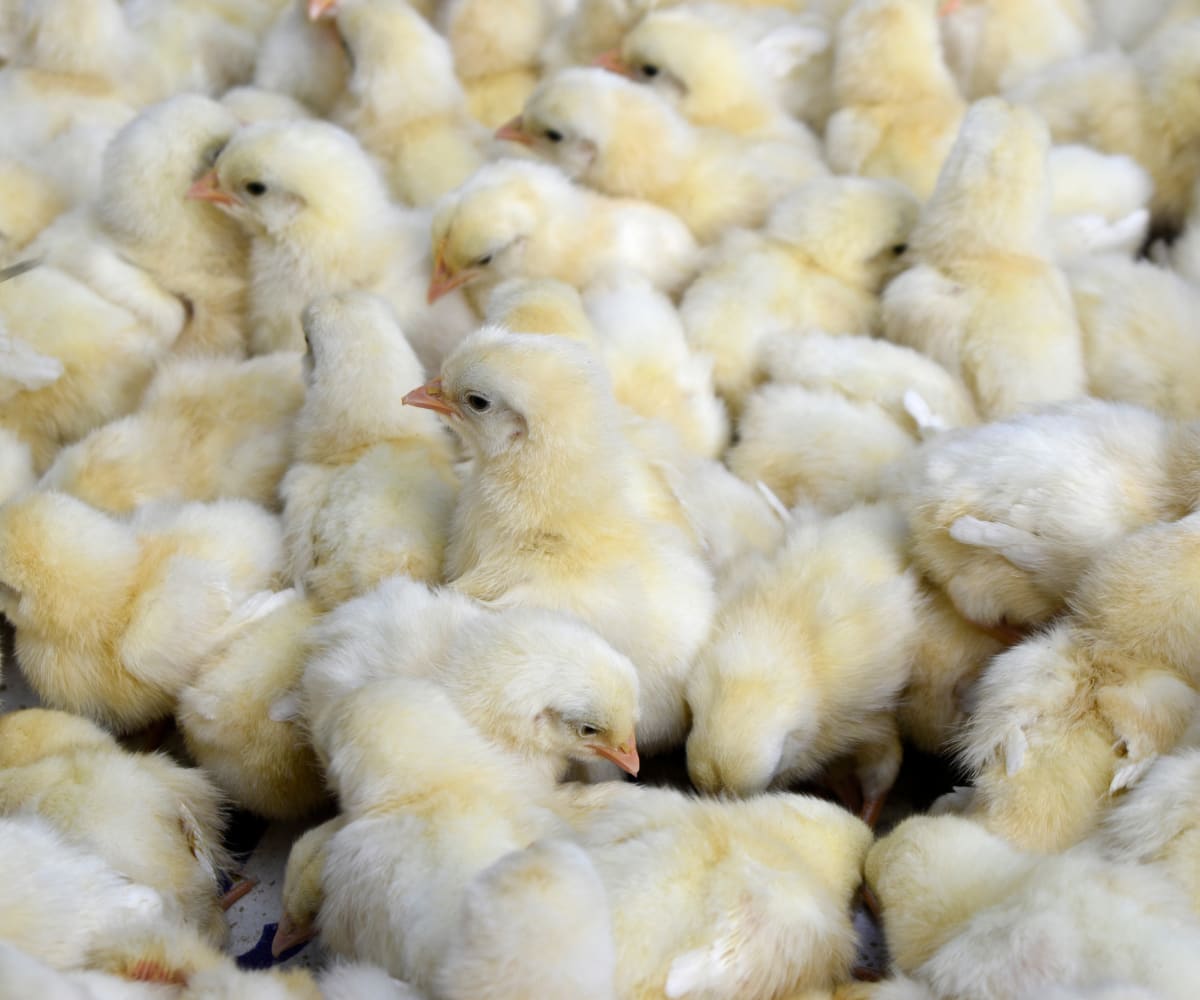When we hear chicken keepers ask about the fact that their chickens are huddling, our first question to them is, “How old are they?” If chicks are huddling, it’s normally because they are too cold. If adult chickens are huddling, it’s usually because they have a fever. Why do these situations happen, and what can you do about it?
Why do baby chicks huddle together?

Newly placed chicks rely on their grower for—well, everything! One of the most important things you can do for chicks is keep them warm. For the first two weeks of their lives, chickens are poikilothermic, which means they can't regulate their own temperature. This is the entire reason that broiler chicks have a brooding period before the house temperature can be reduced for the rest of the grow out.
Young birds are extremely responsive to changes in environmental temperature. Research has shown that even one degree of body temperature variation can cause stress, while prolonged chilling or heat stress can result in poor growth, poor feed conversion and increased susceptibility to disease. These impacts aren’t always short lived either. In more extreme cases, you might see the effects through the entire grow out, resulting in inconsistent sizing and higher production costs per pound of meat or started pullet.
How can you tell if your chicks are extremely cold? What can you do to prevent this from happening? This is where the huddling comes in. Huddling is the number one sign that your chicks are too cold. When the temperature drops, chicks will cluster together to stay warm, sharing and conserving as much body heat as possible. If you walk into a brooding house, you want to see chicks evenly distributed across the floor. Finding them huddled in groups near the supplemental heat sources, such as a heat lamp, is a definite sign that the house is too cold. You may be wondering, "Can chickens smother each other?" While not always the case, it's possible for chickens to smother each other, so it's especially important to take measures to prevent huddling.
What should you do if young chickens start huddling together?
It seems like a pretty easy fix. The chicks are too cold, so let’s turn up the heat, right? Well, it’s not always that simple. Unfortunately, sometimes the damage is already done. There are a couple of long-lasting effects to cold stress in chicks.
During the initial temperature change, you might see an increase in feed consumption as the chicks burn extra calories to warm their bodies. This can impact your feed conversion for the entire grow out. Birds that undergo cold stress at a young age have also been shown to be more prone to intestinal disease and ascites.
Depending on the length of time the chicks spent huddled, they may also accumulate waste. This can lead to dermatitis as well as residual wet spots in the house.
What can you do to prevent these things from happening?
Follow Brooding Guidelines
Follow the guidelines for brooding that match your house and your style of brooders. Temperatures and setting may vary based on the type of equipment you have. Years and years of research have given us the ability to optimize our housing and heating to support young chicks, so use it!
Preheat Houses
If you aren’t already, preheat your houses. This way, when chicks hit the ground, it is already exactly how they like it without a lag period for heating. This is especially important during cold weather.
Provide Probiotics and Vitamins
If your chicks do experience a cold stress event for whatever reason, offer them some support to get them back on track. Probiotics and vitamins can be a great way to encourage the systems that might have been compromised.
Why do adult chickens huddle together?

You may find your adult chickens huddled in the corner of your farm, hen house or inside a nest box. But why? Adult birds are a little different than chicks. Since they are more temperature tolerant than chicks, they huddle for different reasons, including not enough roosting space, a potential predator threat and—the most common reason—fever. Fevers are a natural response to inflammation caused by bacteria or viruses. Once the body detects an intruder, the body temperature rises to begin healing.
While fever can be a great way to drive out whatever is causing it, we all know it can cause some secondary problems too. Common secondary problems include chills, dehydration and lethargy—all of which can be detrimental to a growing bird.
What should you do if adults chickens start huddling together?

To prevent secondary problems, it is important to find feverish birds as soon as possible. Most often, huddling and fever are followed by mortality, so the sooner you can find the problem, the better.
When birds are experiencing a fever, they can use as much immune and hydration support as you can give them. Incorporate vitamins and electrolytes as soon as you notice huddling. Or better yet, add vitamins and electrolytes into their regular nutrition program to boost overall poultry health.
Keep Your Shadow on Your Farm
The best thing you can do is to lay eyes on your birds and find the problem early. After all, the best piece of equipment on your farm is your shadow. Spend time in your houses, catch problems like huddling early, correct them quickly and you will see a lot less of the long-term effects down the road.
Contact Us
As always, you can reach us at success@southlandorganics.com or 800-608-3755 if you have any questions. Contact Allen Reynolds at allen@southlandorganics.com for any questions about our products. Be sure to subscribe to our YouTube channel, so you're the first to know when we make more helpful videos for poultry farmers like you.
Sources
https://www.sciencedirect.com/science/article/pii/S0032579119411280






